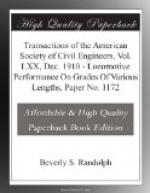The question of the effect of sea water on the concrete was given much thought. The writer is unable to find any authoritative opinions on this subject which are not directly controverted by equally authoritative opinions of a diametrically opposite nature. He thinks it is a question that this Society might well undertake to investigate promptly and thoroughly. There can be no question that there are many distressing instances of failures due to the action of sea water and frost on concrete, and that many able and experienced engineers in charge of the engineering departments of the great transportation companies have simply crossed concrete off their list of available materials when it comes to marine construction. It is a subject too large in itself to be discussed as subsidiary to a minor structure like the one herein described, and though many have rejected concrete under these conditions, other engineers equally conservative are using it freely and without fear.
The writer consulted with his partner and others at some length, and, considering all the advantages to accrue by the use of these concrete caissons, decided to do so after taking all known precautions.
[Illustration: Fig. 1.]
These precautions consisted in:
First, the use of cement in which the chemical constituents were limited as follows:
It was specified that the cement should not contain more than 1.75% of anhydrous sulphuric acid (so_{3}) nor more than 3% of magnesia (MgO); also that no addition greater than 3% should have been made to the ingredients making up the cement subsequent to calcination.
Secondly, to secure by careful inspection the most completely homogeneous mixture possible, with especial care in the density of the outer skin of the caissons.
Thirdly, a prolonged seasoning process before the new concrete should be immersed in the sea water.
In addition to these well-known precautions, it was decided to try the addition to the cement of a chemical element that should make with the free lime in the cement a more stable and indissoluble chemical combination than is offered by the ordinary form of Portland cement. This was furnished by the patent compound known as “Toxement,” which is claimed by the inventor to be a resinate of calcium and silicate of alumina, which generates a resinate of lime and a silicate of alumina in crystalline form. It is further claimed that each of these materials is insoluble in sodium chloride and sodium sulphate, 3% solution. It was used in all the caissons, excepting Nos. 1 and 2, in the proportions of 2 lb. of Toxement to each 100 lb. of cement. The first two caissons were not thus treated, and will be held under close observation and comparison with the others, which were treated with this compound.
The mixture used was one of cement (Pennsylvania brand), two of sand, and four of gravel. The sand and gravel were from the nearby Cow Bay supply, and screened and washed. None of the gravel was larger than 1/2 in., grading down from that to very coarse sand. The sand was also run-of-bank, and very well graded.




